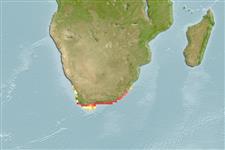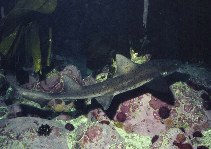Triakis megalopterus (Smith, 1839)
Sharptooth houndshark
Waarneming toevoegen in Fish Watcher
| Native range | All suitable habitat | Point map | Year 2050 |

|
| This map was computer-generated and has not yet been reviewed. |
| Triakis megalopterus AquaMaps Data sources: GBIF OBIS |
Uploaden van uw Foto's en video's
Pictures | Google afbeeldingTriakis megalopterus
Picture by Zsilavecz, G.
Pictures | Google afbeeldingTriakis megalopterus
Picture by Zsilavecz, G.
South Africa country information
Common names:
Gespikkelde sloothaai, Spotted gully shark, Spotted gullyshark
Occurrence: native
Salinity: marine
Abundance: common (usually seen) | Ref: van der Elst, R.P. and F. Adkin (eds.), 1991
Importance: minor commercial | Ref: Compagno, L.J.V., 1984
Aquaculture: | Ref:
Regulations: no regulations | Ref: van der Elst, R., 1993
Uses: gamefish: yes;
Comments: Ranges from the west coast to Coffee Bay, Transkei; rarely off Natal. Stock sound; commonly caught by rock and surf tournament anglers (Ref. 4332). There is a fairly large commercial fishery in Gans Bay (Ref. 244). Also Ref. 5485, 12484.
National Checklist:
Country Information: https://www.cia.gov/library/publications/resources/the-world-factbook/geos/sf.html
National Fisheries Authority:
Occurrences: Occurrences Point map
Main Ref: Compagno, L.J.V., D.A. Ebert and M.J. Smale, 1989
National Database:
Occurrence: native
Salinity: marine
Abundance: common (usually seen) | Ref: van der Elst, R.P. and F. Adkin (eds.), 1991
Importance: minor commercial | Ref: Compagno, L.J.V., 1984
Aquaculture: | Ref:
Regulations: no regulations | Ref: van der Elst, R., 1993
Uses: gamefish: yes;
Comments: Ranges from the west coast to Coffee Bay, Transkei; rarely off Natal. Stock sound; commonly caught by rock and surf tournament anglers (Ref. 4332). There is a fairly large commercial fishery in Gans Bay (Ref. 244). Also Ref. 5485, 12484.
National Checklist:
Country Information: https://www.cia.gov/library/publications/resources/the-world-factbook/geos/sf.html
National Fisheries Authority:
Occurrences: Occurrences Point map
Main Ref: Compagno, L.J.V., D.A. Ebert and M.J. Smale, 1989
National Database:
Common names from other countries
Classificatie / Names Lokale namen | Synoniemen | Catalog of Fishes(Genus, Soort(en)) | ITIS | CoL | WoRMS | Cloffa
Elasmobranchii (haaien en roggen) (sharks and rays) > Carcharhiniformes (Ground sharks) > Triakidae (Houndsharks) > Triakinae
Etymology: Triakis: tri-, from tres (L.), three; akis (Gr.), point, referring to each tooth consisting of one large central cusp flanked on by both sides by a small cusplet (See ETYFish); megalopterus: mega-, from megas (Gr.), large; pterus (Gr.), fin, referring to its broad, large fins (See ETYFish).
More on author: Smith.
Etymology: Triakis: tri-, from tres (L.), three; akis (Gr.), point, referring to each tooth consisting of one large central cusp flanked on by both sides by a small cusplet (See ETYFish); megalopterus: mega-, from megas (Gr.), large; pterus (Gr.), fin, referring to its broad, large fins (See ETYFish).
More on author: Smith.
Environment: milieu / climate zone / depth range / distribution range Ecologie
marien demersaal; diepte 1 - 50 m (Ref. 5578). Subtropical; 30°S - 36°S
Verspreiding Landen | FAO regio's | Ecosystemen | Voorkomen | Point map | Introducties | Faunafri
Southeast Atlantic: Namibia to Coffee Bay, South Africa.
Lengte bij maturiteit / Grootte / Gewicht / Leeftijd
Maturity: Lm 145.0, range 140 - 150 cm
Max length : 142 cm TL mannelijk / geslacht onbekend; (Ref. 244); 174.0 cm TL (female); max. gepubliceerd gewicht: 20.0 kg (Ref. 5485)
Max length : 142 cm TL mannelijk / geslacht onbekend; (Ref. 244); 174.0 cm TL (female); max. gepubliceerd gewicht: 20.0 kg (Ref. 5485)
Korte beschrijving Determinatiesleutels | Morfologie | Morfometrie
Dorsale stekels (totaal) : 0; Anale stekels: 0. Blunt snout and a large mouth with small pointed teeth; caudal peduncle short and heavy (Ref. 5578). Grey with numerous black spots which may be sparse or absent in some specimens; new born pups with fewer black spots compared to adults (Ref. 5485); white below (Ref. 5578).
Occurs off sandy beaches, rocky shores and in shallow bays (Ref. 5578). Feeds on crabs, lobsters, bony fish and small sharks (Ref. 5578). Ovoviviparous (Ref. 50449). Forms schools in summer (Ref. 244). Hardy and keeps well in captivity (Ref. 244). Commonly caught by rock and surf sports anglers but not eaten much (Ref. 244). Meat is dried into shark 'biltong' or jerky which commands a relatively high price (Ref. 244). Attains 160 cm, TL (Ref. 36731).
Levenscyclus en paargedrag Maturiteit | Voortplanting | Paaien | Eieren | Fecunditeit | Larven
Ovoviviparous, embryos feed solely on yolk (Ref. 50449), with 6 to 12 young in a litter (Ref. 244). 30-32 cm at birth (Ref. 244).
Hoofdreferentie
Upload your references | Referenties | Coördinator : Compagno, Leonard J.V. | Medewerkers
Compagno, L.J.V., 1984. FAO Species Catalogue. Vol. 4. Sharks of the world. An annotated and illustrated catalogue of shark species known to date. Part 2 - Carcharhiniformes. FAO Fish. Synop. 125(4/2):251-655. Rome: FAO. (Ref. 244)
Status op de Rode Lijst van het IUCN (Ref. 130435: Version 2024-2)
Niet bedreigd (LC) ; Date assessed: 01 August 2019
Gevaar voor de mens
Harmless
Gebruik door de mens
Visserij: van minder commercieel belang; sportvis: ja; Aquarium: Publieke aquaria
FAO(visserij: productie; publication : search) | FishSource | Sea Around Us
Meer informatie
Population dynamics
Groeiparameters
Max. ages / sizes
Length-weight rel.
Length-length rel.
Lengtefrequenties
Massaconversie
Rekrutering
Abundantie
Groeiparameters
Max. ages / sizes
Length-weight rel.
Length-length rel.
Lengtefrequenties
Massaconversie
Rekrutering
Abundantie
Life cycle
Voortplanting
Maturiteit
Fecunditeit
Paaien
Spawning aggregations
Eieren
Ontwikkeling van de eieren
Larven
Larvale populatiedynamiek
Voortplanting
Maturiteit
Fecunditeit
Paaien
Spawning aggregations
Eieren
Ontwikkeling van de eieren
Larven
Larvale populatiedynamiek
Anatomy
Kieuwoppervlak
Brain
Otolith
Kieuwoppervlak
Brain
Otolith
Physiology
Body composition
Nutrients
Zuurstofverbruik
Zwemtype
Zwemsnelheid
Visual pigments
Fish sound
Diseases & Parasites
Toxicity (LC50s)
Body composition
Nutrients
Zuurstofverbruik
Zwemtype
Zwemsnelheid
Visual pigments
Fish sound
Diseases & Parasites
Toxicity (LC50s)
Genetics
Genetica
Heterozygosity
Erfelijkheid
Genetica
Heterozygosity
Erfelijkheid
Human related
Aquaculture systems
Aquacultuurprofielen
Kweeklijnen
Ciguatera cases
Stamps, coins, misc.
Aquaculture systems
Aquacultuurprofielen
Kweeklijnen
Ciguatera cases
Stamps, coins, misc.
Tools
Bio-Quiz | E-boek | Veldgids | Lengtefrequentie Tool | Levenscyclus tool | Verspreidingskaart | Classification Tree
| Catch-MSY |
Speciale rapporten
Bekijk gegevens voor het houden in een aquarium | Bekijk Fact Sheets voor de soort | Bekijk Aquacultuur Fact Sheets
Download XML
Internetbronnen
Aquatic Commons | BHL | Cloffa | Websites from users | Bekijk FishWatcher | CISTI | Catalog of Fishes(Genus, Soort(en)) | DiscoverLife | ECOTOX | Faunafri | Fishtrace | GenBank(genoom, nucleotide) | GloBI | GOBASE | | Google Books | Google Scholar | Google | IGFA World Record | MitoFish | Otolith Atlas of Taiwan Fishes | Publieke aquaria | PubMed | Reef Life Survey | Scirus | SeaLifeBase | Tree of Life | Wikipedia(ga naar, zoek) | World Records Freshwater Fishing | Zoological Record
Estimates based on models
Preferred temperature (Ref. 115969): 15.8 - 22.4, mean 19.3 (based on 26 cells).
Fylogenetische diversiteitsindex (Ref. 82804): PD50 = 0.5312 [Uniqueness, from 0.5 = low to 2.0 = high].
Bayesian length-weight: a=0.00245 (0.00114 - 0.00526), b=3.13 (2.95 - 3.31), in cm Total Length, based on LWR estimates for this (Sub)family-body shape (Ref. 93245).
Trofisch niveau (Ref. 69278): 4.0 ±0.5 se; based on diet studies.
Weerstandsvermogen (Ref. 120179): Zeer laag, minimale populatieverdubbelingstijd meer dan 14 jaar (Fec=6).
Fishing Vulnerability (Ref. 59153): Very high vulnerability (90 of 100).




